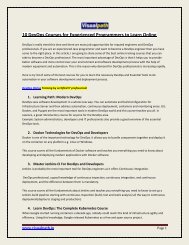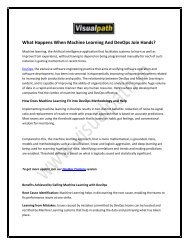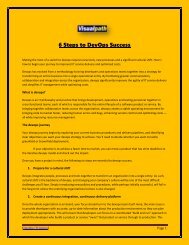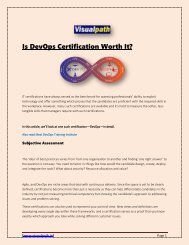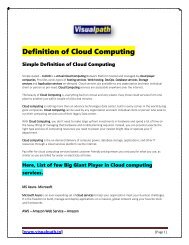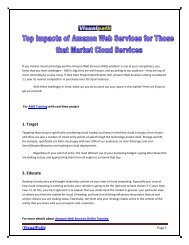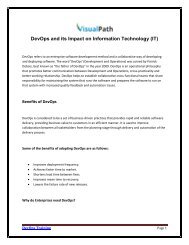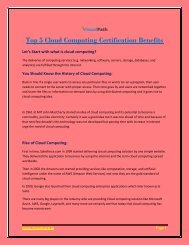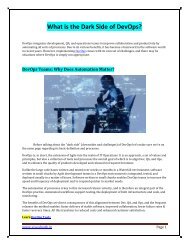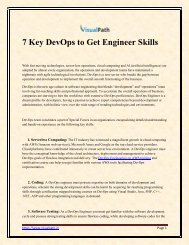Top 8 Common AWS EC2 Interview Questions and Answers
Top 8 Common AWS EC2 Interview Questions and Answers
Top 8 Common AWS EC2 Interview Questions and Answers
You also want an ePaper? Increase the reach of your titles
YUMPU automatically turns print PDFs into web optimized ePapers that Google loves.
though can sit anywhere physically on a disk, so Linux can boot from an arbitrary location on the EBS storage<br />
network.<br />
Build a new AMI by first spinning up <strong>and</strong> instance from a trusted AMI. Then adding packages <strong>and</strong> components as<br />
required. Be wary of putting sensitive data onto an AMI. For instance your access credentials should be added to<br />
an instance after spinup. With a database, mount an outside volume that holds your MySQL data after spinup as<br />
well.<br />
Q5). What automation tools can I use to spinup servers?<br />
Ans: The most obvious way is to roll-your-own scripts, <strong>and</strong> use the <strong>AWS</strong> API tools. Such scripts could be written in<br />
bash, perl or other language or your choice. Next option is to use a configuration management <strong>and</strong> provisioning<br />
tool like puppet or better it’s successor Opscode Chef. You might also look towards a tool like Scalr. Lastly you can<br />
go with a managed solution such as Rightscale.<br />
Q6). What is auto-scaling? How does it work?<br />
Ans: Autoscaling is a feature of <strong>AWS</strong> which allows you to configure <strong>and</strong> automatically provision <strong>and</strong> spinup new<br />
instances without the need for your intervention. You do this by setting thresholds <strong>and</strong> metrics to monitor. When<br />
those thresholds are crossed a new instance of your choosing will be spun up, configured, <strong>and</strong> rolled into the load<br />
balancer pool. Voila you’ve scaled horizontally without any operator intervention!<br />
Amazon Web Services Online Training by the real-time experts<br />
Q7). Explain how you would simulate perimeter security using Amazon Web Services model?<br />
Ans: Traditional perimeter security that we’re already familiar with using firewalls <strong>and</strong> so forth is not supported in<br />
the Amazon <strong>EC2</strong> world. <strong>AWS</strong> supports security groups. One can create a security group for a jump box with ssh<br />
access – only port 22 open. From there a webserver group <strong>and</strong> database group are created. The webserver group<br />
allows 80 <strong>and</strong> 443 from the world, but port 22 *only* from the jump box group. Further the database group<br />
allows port 3306 from the webserver group <strong>and</strong> port 22 from the jump box group. Add any machines to the<br />
webserver group <strong>and</strong> they can all hit the database. No one from the world can, <strong>and</strong> no one can directly ssh to any<br />
of your boxes.<br />
Q8). What is configuration management? Why would I want to use it with cloud provisioning of<br />
resources?<br />
Ans: Configuration management has been around for a long time in web operations <strong>and</strong> systems administration.<br />
Yet the cultural popularity of it has been limited. Most systems administrators configure machines as software<br />
was developed before version control – that is manually making changes on servers. Each server can then <strong>and</strong><br />
www.Visualpath.in Page 2




